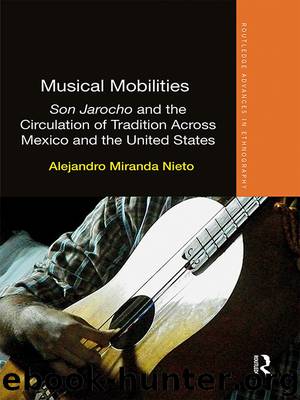Musical Mobilities: Son Jarocho and the Circulation of Tradition Across Mexico and the United States by Miranda Nieto Alejandro

Author:Miranda Nieto, Alejandro
Language: eng
Format: epub
Publisher: Routledge
Figure 3.2 In constant search of the right tuning
Conclusion: changing as it moves
The practice of traditional son jarocho is currently moving fast and far. Its contemporary mobilities are providing resources for the creation and negotiation of meanings on the move. The interplay between routine and improvisation, the rhythmic circulation around the tarima, the production of spatio-temporal configurations and the dissemination of this practice through workshops are examples of multiple processes of mobility that extend across networks of relationships. Regardless of their place of residence, most contemporary son jarocho practitioners have some awareness of taking part in a living tradition and engaging with an ongoing past. This conscious perception contrasts with the apparently unpremeditated, spontaneous perspective of those who learnt ‘just by doing it at fandangos’ through extended exposure to the practice. Workshops have become the predominant space in which to attain the capacity to judge and be positioned in space and time that is required at performances, as well as the main device through which a tradition has been reproduced, mobilised and shared.
The diffusion of practice-specific knowledge is dependent on processes of codification, de-codification and re-codification of know-how. Enthusiasts from Sotavento have carried out the abstraction of tacit understandings for a number of decades, a process that has emerged from the reinvention of traditional son jarocho. At the same time, this process has relied on the capacity of groups of practitioners to reverse or unpack this know-how. A point to note here is that the co-, de- and re-codification of practice-specific knowledge are processes that occur primarily at workshops, entailing face-to-face interaction and with almost no written registers. Nevertheless, there is a growing corpus of information in the form of digital videos and images on the Internet, generated and circulated by practitioners. New configurations between the know-how, artefacts and meanings of this practice may emerge from these arrangements.
This practice is changing as it moves. The efforts to preserve it have been also accompanied by gradual, yet discernible, changes in the repertoires of bodily gestures, routines and rules as they are recreated. Contrasting with the rural way of life that is described in the verses that are learnt by heart at workshops and sung at fandangos, a large proportion of practitioners learn and perform son jarocho in entirely different environments – as the issue of recalling a rhythm in reference to a galloping horse revealed. ‘How to sing the verses of [the son called] “La Guacamaya” (The Macaw) if we have hardly ever seen one?’, a jaranero once told me as we were leaving a fandango in the American northwest. Many of the old verses that have been passed from generation to generation are gradually acquiring new meanings; some new verses are extemporised, taking into account the different contexts in which performances take place. The adaptation of musical phrases and other stylistic elements, the use of commercial recordings to establish standards of excellence, or the increasing standardisation of the repertoire are some of the markers of these transformations. These apparently mundane
Download
This site does not store any files on its server. We only index and link to content provided by other sites. Please contact the content providers to delete copyright contents if any and email us, we'll remove relevant links or contents immediately.
Aircraft Design of WWII: A Sketchbook by Lockheed Aircraft Corporation(31777)
The Great Music City by Andrea Baker(21441)
Call Me by Your Name by André Aciman(18974)
The Art of Boudoir Photography: How to Create Stunning Photographs of Women by Christa Meola(17849)
Shoot Sexy by Ryan Armbrust(17148)
The Secret History by Donna Tartt(16641)
Plagued by Fire by Paul Hendrickson(16641)
Portrait Mastery in Black & White: Learn the Signature Style of a Legendary Photographer by Tim Kelly(16490)
Adobe Camera Raw For Digital Photographers Only by Rob Sheppard(16391)
Photographically Speaking: A Deeper Look at Creating Stronger Images (Eva Spring's Library) by David duChemin(16163)
Bombshells: Glamour Girls of a Lifetime by Sullivan Steve(13114)
Pimp by Iceberg Slim(12938)
Ready Player One by Cline Ernest(12849)
The Goal (Off-Campus #4) by Elle Kennedy(12437)
Art Nude Photography Explained: How to Photograph and Understand Great Art Nude Images by Simon Walden(12351)
Kathy Andrews Collection by Kathy Andrews(10535)
Thirteen Reasons Why by Jay Asher(7796)
Wonder by R.J. Palacio(7737)
Goodbye, Things by Fumio Sasaki(7733)
